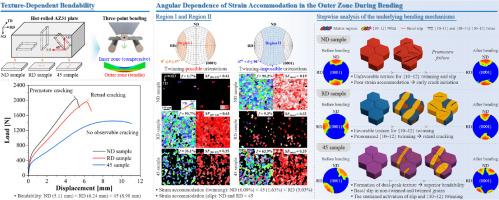Influence of initial texture on twinning and slip behaviors in rolled AZ31 magnesium alloy during three-point bending deformation
IF 13.8
1区 材料科学
Q1 METALLURGY & METALLURGICAL ENGINEERING
引用次数: 0
Abstract
This study investigates the influence of initial crystallographic texture on the deformation mechanisms during three-point bending of AZ31 Mg alloy sheets. Three distinct orientations are examined by using the following bending specimens: (i) the normal direction (ND) sample, where the c-axes are predominantly aligned along the specimen thickness, (ii) the rolling direction (RD) sample, where the c-axes are mostly aligned along the longitudinal direction, and (iii) the 45 sample, where the c-axes are tilted at approximately 45° from both the thickness and longitudinal directions. The bending properties vary significantly depending on the initial texture, thereby affecting the strain accommodation and dominant deformation modes. The ND sample exhibits the lowest bendability due to its unfavorable orientation for {10–12} extension twinning and basal slip, which results in poor strain accommodation and early crack initiation in the outer tensile side. By comparison, the RD sample demonstrates an approximately 22.1 % improvement, with extensive {10–12} extension twinning in the outer tensile zone. Meanwhile, the 45 sample exhibits the highest bendability (approximately 75.7 % greater than that of the ND sample) due to sustained activation of both basal slip and {10–12} extension twinning, promoting uniform strain distribution and delaying fracture. Detailed electron backscatter diffraction analysis reveals that the 45 sample retains favorable crystallographic orientations for basal slip throughout bending, minimizing strain localization and enhancing the bendability. These findings highlight the importance of tailoring the initial texture in order to optimize the bending properties of Mg alloy sheets, and provide valuable insights for improving the manufacturability of Mg-based structural components.

初始织构对轧制AZ31镁合金三点弯曲孪晶和滑移行为的影响
研究了AZ31镁合金板材三点弯曲过程中初始晶构对变形机制的影响。通过使用以下弯曲试样来检查三个不同的方向:(i)法向(ND)试样,其中c轴主要沿着试样厚度对齐,(ii)滚动方向(RD)试样,其中c轴主要沿着纵向对齐,以及(iii) 45试样,其中c轴从厚度和纵向倾斜约45°。弯曲性能的变化取决于初始织构,从而影响应变调节和主要变形模式。ND试样由于{10-12}扩展孪晶和基底滑移的不利取向而表现出最低的可弯曲性,这导致应变调节能力差,在外拉伸侧早期萌生裂纹。相比之下,RD样品显示出大约22.1%的改善,在外部拉伸区有广泛的{10-12}扩展孪晶。同时,由于基底滑移和{10-12}延伸孪晶的持续激活,45试样的可弯曲性最高(比ND试样高约75.7%),促进了应变均匀分布,延缓了断裂。详细的电子背散射衍射分析表明,45样品在整个弯曲过程中保持了有利的基底滑移晶体取向,从而最大限度地减少了应变局部化,提高了可弯曲性。这些发现强调了定制初始织构的重要性,以优化镁合金板材的弯曲性能,并为提高镁基结构部件的可制造性提供了有价值的见解。
本文章由计算机程序翻译,如有差异,请以英文原文为准。
求助全文
约1分钟内获得全文
求助全文
来源期刊

Journal of Magnesium and Alloys
Engineering-Mechanics of Materials
CiteScore
20.20
自引率
14.80%
发文量
52
审稿时长
59 days
期刊介绍:
The Journal of Magnesium and Alloys serves as a global platform for both theoretical and experimental studies in magnesium science and engineering. It welcomes submissions investigating various scientific and engineering factors impacting the metallurgy, processing, microstructure, properties, and applications of magnesium and alloys. The journal covers all aspects of magnesium and alloy research, including raw materials, alloy casting, extrusion and deformation, corrosion and surface treatment, joining and machining, simulation and modeling, microstructure evolution and mechanical properties, new alloy development, magnesium-based composites, bio-materials and energy materials, applications, and recycling.
 求助内容:
求助内容: 应助结果提醒方式:
应助结果提醒方式:


